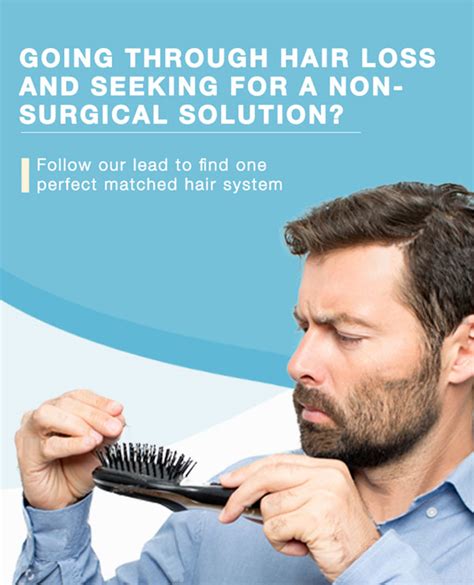Introduction
Millions of men worldwide struggle with hair loss, which can lead to significant emotional distress and reduced self-esteem. However, advancements in hair restoration techniques have introduced male hair systems as a reliable solution to this common issue. This comprehensive guide delves into the world of male hair systems, providing detailed insights into their benefits, types, maintenance, and considerations.

Types of Male Hair Systems
Male hair systems come in various types, each suited to different hair loss patterns and preferences. The two primary categories are:
1. Non-Surgical Hair Systems:
- Lace Base Systems: These systems are constructed on a thin, transparent lace base that allows for natural-looking hair growth. They are lightweight and breathable, making them comfortable to wear for extended periods.
- Skin Base Systems: Similar to lace base systems, but with a silicone base that adheres directly to the scalp, creating an undetectable appearance.
- Polyurethane Base Systems: These systems employ a durable polyurethane base, providing a cost-effective option that offers a degree of flexibility.
2. Surgical Hair Systems:
- Follicular Unit Extraction (FUE): This involves removing individual hair follicles from the back of the scalp and transplanting them to the balding areas, resulting in permanent hair growth.
- Follicular Unit Transplantation (FUT): Also known as strip harvesting, this technique involves removing a strip of skin from the back of the scalp and extracting individual hair follicles for transplantation.
Benefits of Male Hair Systems
Male hair systems offer several advantages over other hair loss treatments:
- Natural Appearance: Modern hair systems seamlessly integrate with existing hair, creating a natural and undetectable look.
- Immediate Results: Unlike surgical procedures that require time for growth, hair systems provide immediate volume and coverage, boosting confidence.
- Convenience: Hair systems require minimal maintenance compared to hair transplants and can be easily removed for cleaning or adjustment.
- Customization: Systems are available in various textures, colors, and densities, allowing for personalization to match individual hair characteristics.
Choosing the Right Male Hair System
Selecting the right male hair system requires careful consideration of factors such as:
- Hair Loss Pattern: The type and extent of hair loss will influence the size and construction of the hair system.
- Hair Characteristics: Matching the texture, color, and density of the hair system to existing hair is crucial for a natural blend.
- Lifestyle: Active individuals may prefer more durable and breathable systems, while professional settings demand a low-maintenance option.
- Budget: The cost of hair systems varies depending on the type, size, and customization required.
Maintenance of Male Hair Systems
Proper maintenance is essential to ensure the longevity and performance of a male hair system. Key steps include:
- Daily Brushing: Gentle brushing with a soft-bristled brush helps detangle and prevent tangles.
- Regular Shampooing: Washing the hair system with a mild, sulfate-free shampoo keeps it clean and prevents buildup.
- Conditioning: Conditioning the hair system with a moisturizing conditioner adds softness and reduces frizz.
- Storage: When not in use, store the hair system in a cool, dry place to prevent damage or deformation.
Considerations for Male Hair Systems
While male hair systems offer impressive benefits, there are certain considerations to keep in mind:
- Initial Cost: Hair systems can be expensive, especially for high-quality, custom-made options.
- Maintenance Costs: Regular maintenance and professional salon visits may incur additional expenses.
- Potential Side Effects: Some individuals may experience scalp irritation or allergic reactions to the adhesives used in hair systems.
- Limited Longevity: Hair systems are not permanent and will require replacement over time, depending on the type and usage.
Pros and Cons of Male Hair Systems
| Pros | Cons |
|---|---|
| Immediate results | Costly |
| Natural appearance | Requires maintenance |
| Convenient | Not permanent |
| Customizable | Potential side effects |
| Boosts confidence | Time commitment |
The Future of Male Hair Systems
The field of male hair systems is constantly evolving, with innovative technologies and materials emerging. Some exciting future applications include:
- Advanced Base Materials: Researchers are developing new base materials that enhance breathability, durability, and customization.
- Bioengineered Hair: Advances in tissue engineering hold promise for creating artificial hair with natural properties and longevity.
- Smart Hair Systems: Future hair systems may integrate sensors and other technology to monitor hair health and provide personalized styling recommendations.
Conclusion
Male hair systems offer a transformative solution to hair loss, restoring confidence and enhancing self-esteem. Understanding the different types, benefits, and maintenance of hair systems empowers men to make informed decisions about this valuable hair restoration option. As technology advances, future male hair systems promise even more convenience, naturalness, and longevity.
